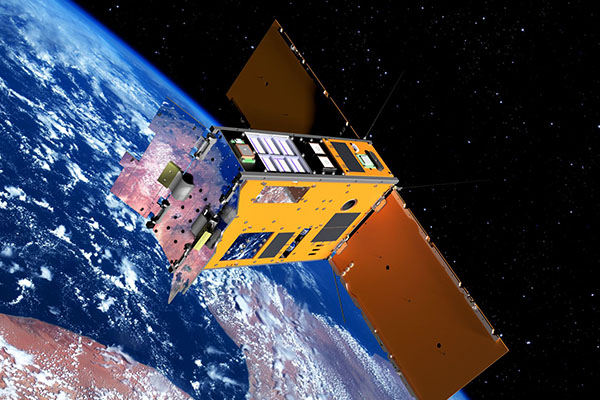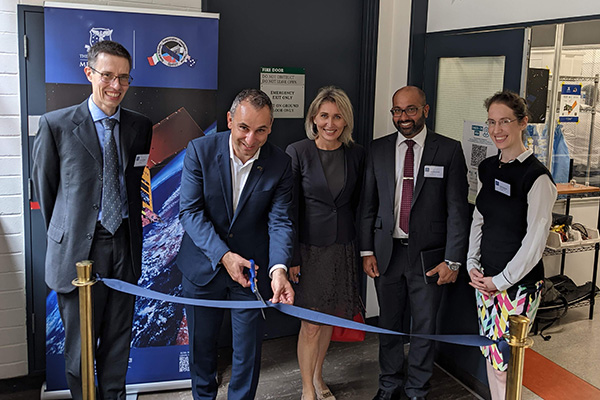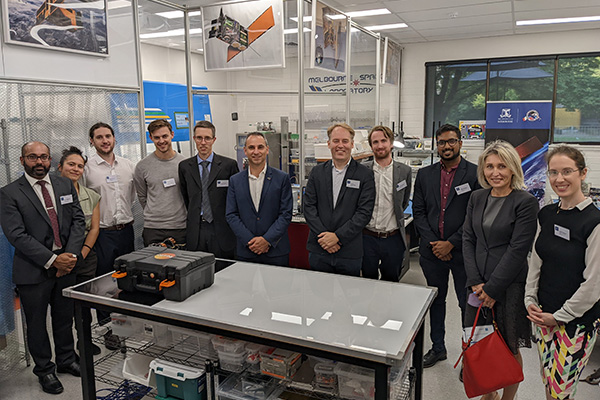The Melbourne Space Laboratory’s first satellite preparing for launch
The SpIRIT CubeSat, an innovative Australian and Italian nano-satellite is on track to be delivered to the launch service provider this year, and to join the hunt for gamma ray bursts, the most powerful explosions in the universe from 2023.
The satellite is being designed and built by a consortium led by the Melbourne Space Laboratory, which was this week officially opened by the Head of the Australian Space Agency and the Consul General of Italy.

Render of the SpIRIT mission in orbit
The lab, located in the School of Physics at the University of Melbourne, was the recipient of a $4 million Australian Space Agency International Space Investment – Expand Capability grant from the Department of Industry, Science, Energy and Resources, to develop the Space Industry Responsive Intelligent Thermal (SpIRIT) satellite mission in cooperation with a consortium of Australian industry partners and the Italian Space Agency.
Head of the Melbourne Space Laboratory, Professor Michele Trenti said the team is preparing to receive a mini x-ray telescope, HERMES, from the Italian Space Agency.
“SpIRIT will contribute to understanding how stars end their lives, giving a glimpse in the first moments of cosmic explosions thanks to the unique microsecond time resolution of the HERMES instrument,” Professor Trenti said.

(L-R) Michele Trenti, Enrico Palermo, Hanna Pappalardo, Chin Wijesuriya and Airlie Chapman opening the Melbourne Space Laboratory
Head of the Australian Space Agency Enrico Palermo said the SpIRIT program delivers against all the pillars of the Agency’s mission - international collaboration, national capacity building and inspiring the nation.
“This is the largest project we are supporting through our International Space Investment initiative and we’re absolutely excited to see the great progress being made,” Mr Palermo said.
“This project is really important for our Strategy because it develops capability, and it is developing the workforce as well. When we look at the companies involved, it’s really a national effort – doing something that’s never been done before.”
The University of Melbourne and the Italian Space Agency recently signed a Letter of Agreement for collaboration on the SpIRIT project.
Consul General of Italy in Melbourne, Ms Hanna Pappalardo, congratulated the team on their progress.
“Today we celebrate a milestone in the robust partnership between Italy and Australia in this strategic centre,” Ms Pappalardo said.
“Research in the space sector requires great dedication, interdisciplinary and international cooperation, as well as continuous technological development.
“I am sure the successful example of SpIRIT will be a gateway for future bilateral cooperation.”
The project successfully passed a key milestone - the Critical Design Review - during the long lockdowns in Melbourne and it is expected to enter the final assembly, integration and test phase in the coming months.
The SpIRIT satellite showcases Australia’s high-performance autonomous operations, communications, propulsion and thermal management capabilities, and will be the first Australian-made spacecraft to host an instrument from a foreign space agency, the HERMES telescope.

The official opening of the Melbourne Space Laboratory
The team has received systems engineering support from Sitael Australia, the flight hardware was developed in partnership with Inovor Technologies and Neumann Space, and Nova Systems is contributing to the Ground Segment.
SpIRIT will contribute to cutting edge research in high energy astrophysics, locating the source of gamma ray bursts, the universe’s most powerful explosions since the big bang, in combination with observations from the six other satellites that are part of the HERMES Technology and Scientific Pathfinder constellation funded by the Italian Space Agency and the European Commission.
SpIRIT Deputy Principal Investigator, Dr Airlie Chapman, from the Department of Mechanical Engineering at the University of Melbourne, is looking forward to the launch of SpIRIT in 2023.
“We are on track construction of SpIRIT this year, followed by a timely launch, to demonstrate the emerging competitiveness of the Australia’s space industry,” Dr Chapman said.
Dean of Science at the University of Melbourne, Professor Moira O’Bryan, said the project was an exciting flagship project for space research at the University of Melbourne.
“The SpIRIT mission is providing hands-on training to grow a highly capable space-sector workforce, through both employment and student internships, and for me this project is particularly exciting in its ability to capture the imagination of the public,” Professor O’Bryan said.
“It is truly forging a new frontier.”